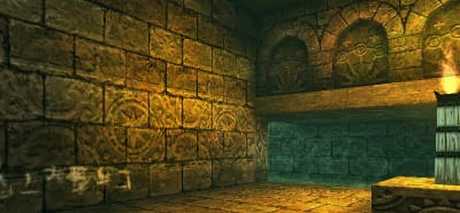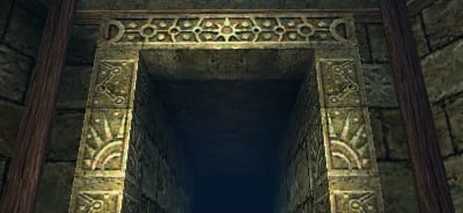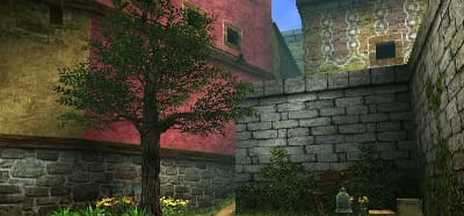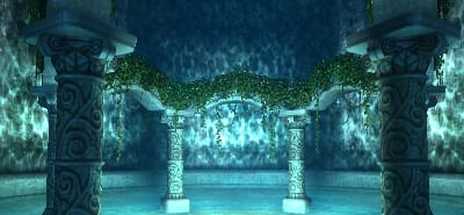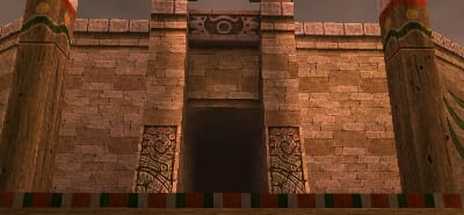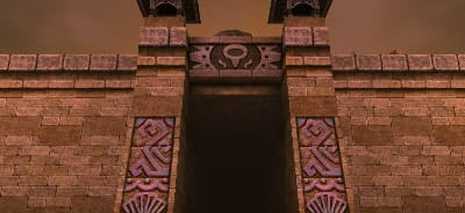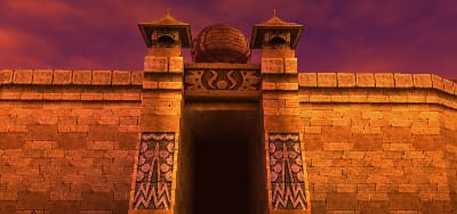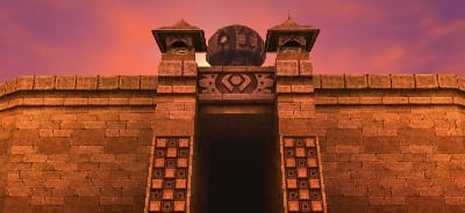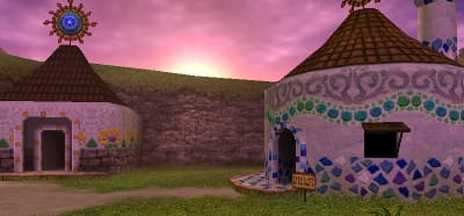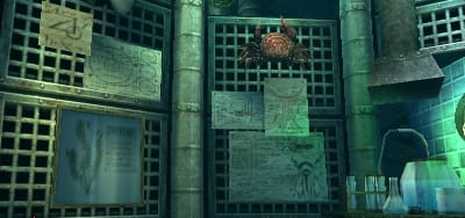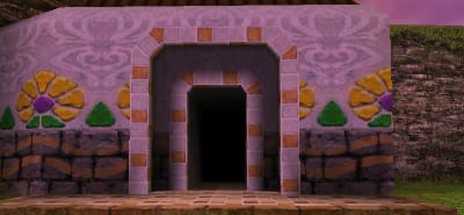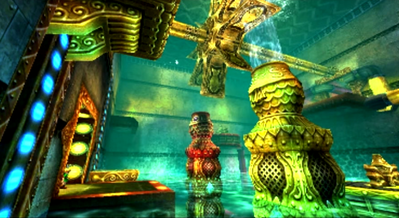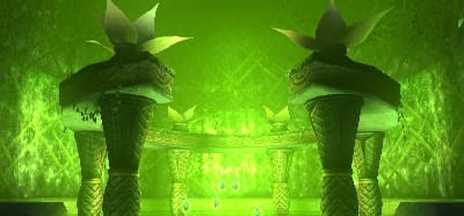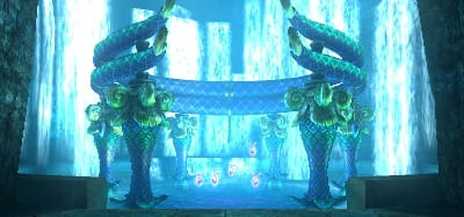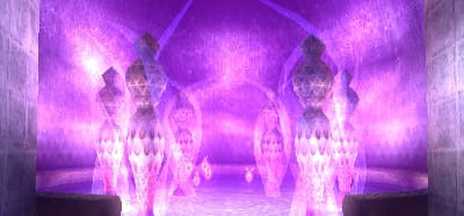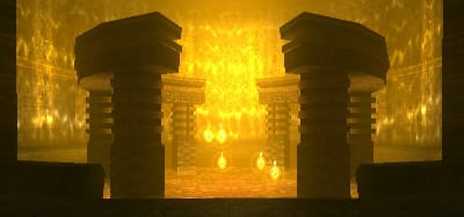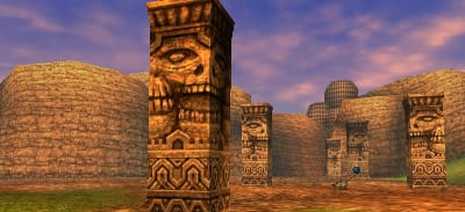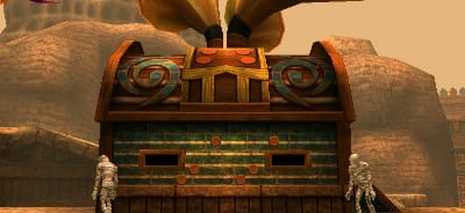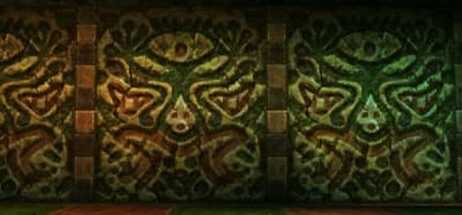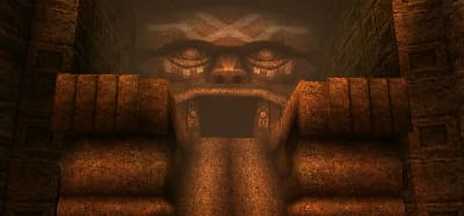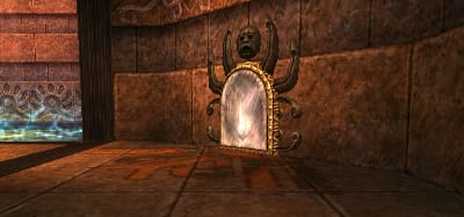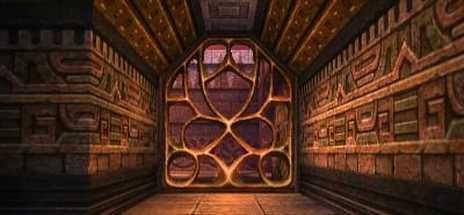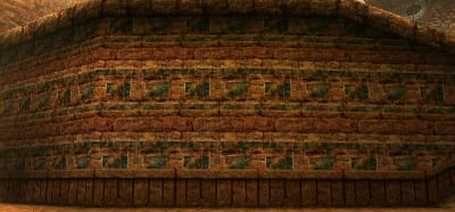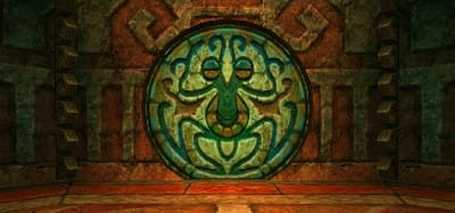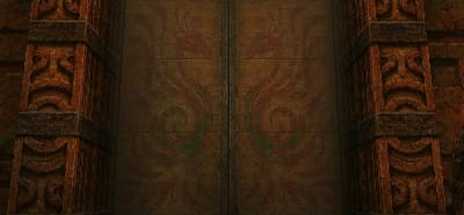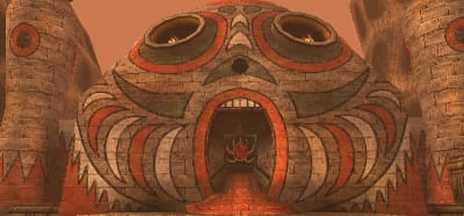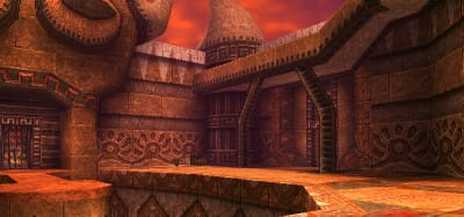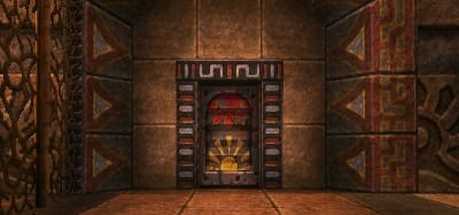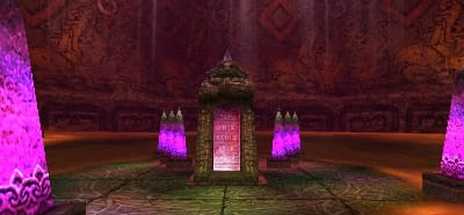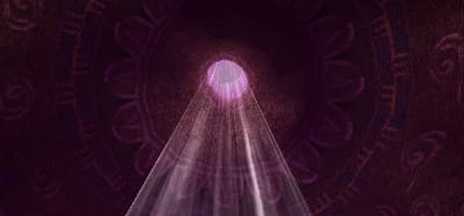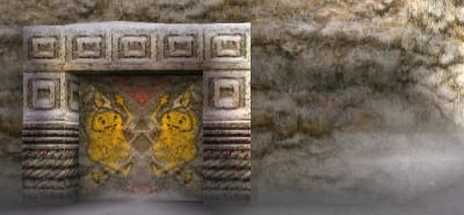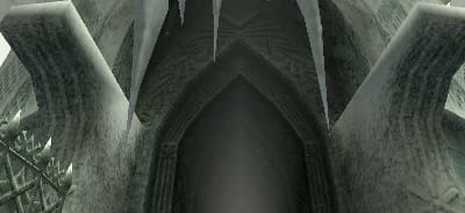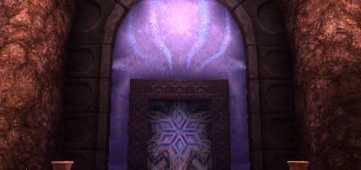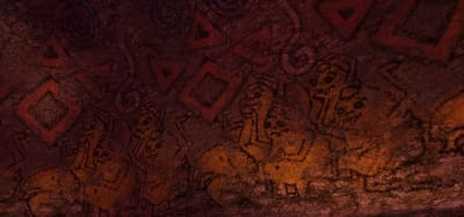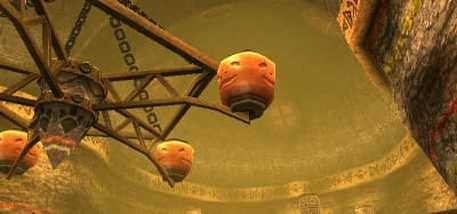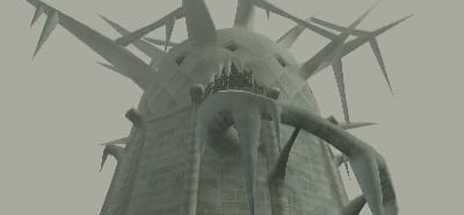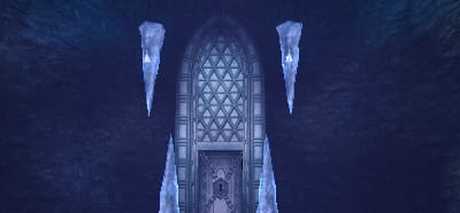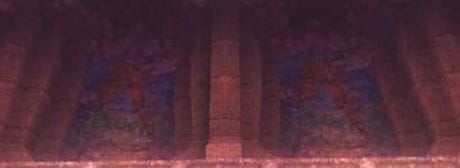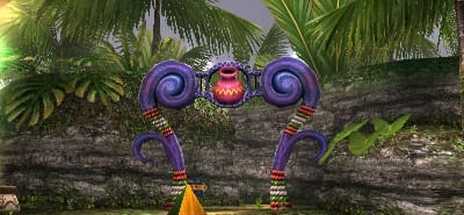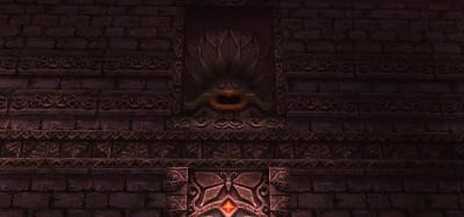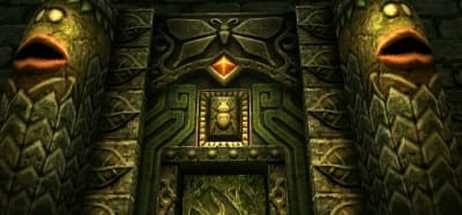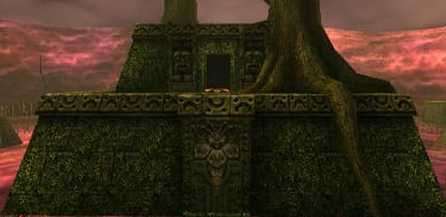An Enumeration of Changes
Here, you will find the major locations within Majora's Mask divided up alphabetically, with a bit of text and a few pictures illustrating any meaningful changes or additions found within the 3DS remake of Majora's Mask. For inclusion on this list, I used these criteria: that the alteration be noticeable to the general player, that it add something to our discussion of architecture and analysis, or that it add or detract from the game's original beauty and mystery.
Bomber's Hideout
Before, the Bomber's Hideout was rather unremarkable. It was a dingy passage underneath Termina Field that terminated at the Astral Observatory. Now, however, its walls are covered with astronomical motifs and childish graffiti. Many bricks in the wall bear stars at random, like a night sky, while the lower portion of the wall carries an encircled star, repeated, and separated by curving lines. The hallway portals are demarcated by piers, with a bright sun and ray design, which gradually changes into an image of space marked with constellations traced across the stars. At random throughout this series of passages, graffiti can be found at a child's height from the ground, depicting bombs, slogans, and the children themselves.
Clock Town
Clock Town, as the world-center of Termina, has been altered significantly. The outer gates, once made with the materials of their respective directions and regions, are now solid stone with two small turrets and flanking reliefs echoing the major themes of each region. The reliefs for Snowhead show a mountain peak with falling snow and clouds, the Great Bay reliefs display shells and cresting waves, the reliefs of the Southern Swamp carry designs of curling ferns and broad leaves, and the relief-stones of Ikana are simple checkerboards of projecting and sunken panels in rust and grey. Above each gate, upon the lintel, is a depiction of the sun, with various runes or clock-face symbols around it.
The laundry pool is more a garden than it was before. There are new balconies high above the water, with a larger tree, brighter wall colors, and a graffitied image of the Bomber's Society with illegible scrawl near the flowerbed.
West Clock Town has undergone major renovations, with colors and designs everywhere upon the wall, new roofs, and many new flags and posters. There are more potted plants in the center of the lane, a faux-crenellation on some of the buildings, and the gate to Great Bay is now surrounded with the same cresting wave design seen outside.
North Clock Town is still a refreshing break from noise and bustle. The playset graffiti has been expanded, and the overgrown ivy on the walls now covers pink and blue designs like lightning, flashing in the sky. The Great Fairy Shrine, like all its sisters, now has two golden wings flanking the entrance, colored in the mantle of each particular fairy, this one being a golden color. The gate to Snowpeak is decorated with large, hexagonal snowflakes.
South Clock Town shows only one radical change. There is a new motif upon the southern walls near the laundry pool, which shows two crossing palm trees of green and red, outlined in white. Above each is a palm leaf, and in between each set of trees is a red flower, open to the sky, with two ferns. The gateway to the Swamp shows a grassy, branching plant in green.
The laundry pool is more a garden than it was before. There are new balconies high above the water, with a larger tree, brighter wall colors, and a graffitied image of the Bomber's Society with illegible scrawl near the flowerbed.
West Clock Town has undergone major renovations, with colors and designs everywhere upon the wall, new roofs, and many new flags and posters. There are more potted plants in the center of the lane, a faux-crenellation on some of the buildings, and the gate to Great Bay is now surrounded with the same cresting wave design seen outside.
North Clock Town is still a refreshing break from noise and bustle. The playset graffiti has been expanded, and the overgrown ivy on the walls now covers pink and blue designs like lightning, flashing in the sky. The Great Fairy Shrine, like all its sisters, now has two golden wings flanking the entrance, colored in the mantle of each particular fairy, this one being a golden color. The gate to Snowpeak is decorated with large, hexagonal snowflakes.
South Clock Town shows only one radical change. There is a new motif upon the southern walls near the laundry pool, which shows two crossing palm trees of green and red, outlined in white. Above each is a palm leaf, and in between each set of trees is a red flower, open to the sky, with two ferns. The gateway to the Swamp shows a grassy, branching plant in green.
Great Bay
The two houses upon the main beach have been newly tiled, carrying new flower designs, with brighter, clearer colors and patterns. The sunbursts upon the houses are now varicolored in navy, orange, and yellow. The Oceanside Spider House subtly carries a hanging spider motif done in an off-white. The Marine Research Center is much the same, but for a water design upon the exterior surface and more papers, diagrams, and apparatus inside. The Pirates' Fortress now displays an enormous design of crossed swords upon the gate to the sea, while the interior has a couple redone motifs of skulls, bones, and other embellishments usually connected to pirates.
Zora Hall bears few alterations, but for more intricate and ornate door decorations surrounding the entrances to the musicians' doors. The exterior to the complex is limned with blue lines, and now has two hanging lanterns upon the fish's tail.
Great Bay Temple is far more ornate and gilded than before. Myriad fish designs now blanket many surfaces, which yields a huge upgrade in looks. Carefully-crafted color schemes, bright and primary, reflect joyously in the water, and the whole complex seems both less dingy, and more alive.
Zora Hall bears few alterations, but for more intricate and ornate door decorations surrounding the entrances to the musicians' doors. The exterior to the complex is limned with blue lines, and now has two hanging lanterns upon the fish's tail.
Great Bay Temple is far more ornate and gilded than before. Myriad fish designs now blanket many surfaces, which yields a huge upgrade in looks. Carefully-crafted color schemes, bright and primary, reflect joyously in the water, and the whole complex seems both less dingy, and more alive.
Great Fairy Shrines
The Fairy Shines are far more beautiful in the 3DS remake than ever they were in the original. The Fairy Shrine in Clock Town is arboreal, with entwined leaves upon the walls, main lintel, and on the drums of each column in the center of the pool. This fountain is covered in a dark ivy, which connects nicely to the naturally-flowing water below.
The Fairy Shrine of the Southern Swamp, carved into the crater-wall of Woodfall, is verdant and green, with an otherworldly sylvan light emanating from the walls. Its columns are of palm trunks and leaves, crowned with lilies, while the cave walls themselves are covered in fine latticework, over which the luminescent, green water flows.
Snowhead's Fairy Fountain is lit with a radiant pink, with huge, vertical flower designs upon the walls. In the pool, there are six statuesque, curvilinear pillars — like ornate vases, decorated with ovals, triangles, and diamonds. Each is entwined by two rising tendrils of ice, reaching toward the vacuous cave ceiling above. In the heart of Snowhead, a land locked in frost and cold, the warmth of this fountain is a true blessing.
The Fairy Fountain found in the Great Bay area is simpler, and more in-tune with the element that defines the region. Illumined with a sapphire lighting, water gently flows down the cave walls and into the pool below. The columns here echo the scales of a fish, curving and undulating as if swimming, and the stones set atop the columns dangle blue gems upon small chains.
The final Fairy Shrine, found within Ikana Canyon, is far less ornate, though still comforting. Long, grey bricks with the same checkerboard pattern seen on the gate leading to the canyon make up part of the wall, and the masonry is generally quite harsh and angular, though still majestic. Nothing representative can be found within this fountain, though angular patterns can be found upon both walls and pillars. A beautiful amber light — at once both brown and gold — illuminates the chamber, giving the seemingly-harsh space both warmth and mildness.
The Fairy Shrine of the Southern Swamp, carved into the crater-wall of Woodfall, is verdant and green, with an otherworldly sylvan light emanating from the walls. Its columns are of palm trunks and leaves, crowned with lilies, while the cave walls themselves are covered in fine latticework, over which the luminescent, green water flows.
Snowhead's Fairy Fountain is lit with a radiant pink, with huge, vertical flower designs upon the walls. In the pool, there are six statuesque, curvilinear pillars — like ornate vases, decorated with ovals, triangles, and diamonds. Each is entwined by two rising tendrils of ice, reaching toward the vacuous cave ceiling above. In the heart of Snowhead, a land locked in frost and cold, the warmth of this fountain is a true blessing.
The Fairy Fountain found in the Great Bay area is simpler, and more in-tune with the element that defines the region. Illumined with a sapphire lighting, water gently flows down the cave walls and into the pool below. The columns here echo the scales of a fish, curving and undulating as if swimming, and the stones set atop the columns dangle blue gems upon small chains.
The final Fairy Shrine, found within Ikana Canyon, is far less ornate, though still comforting. Long, grey bricks with the same checkerboard pattern seen on the gate leading to the canyon make up part of the wall, and the masonry is generally quite harsh and angular, though still majestic. Nothing representative can be found within this fountain, though angular patterns can be found upon both walls and pillars. A beautiful amber light — at once both brown and gold — illuminates the chamber, giving the seemingly-harsh space both warmth and mildness.
Ikana Valley
The pillars marking the route to Ikana Valley are now clearer and more ornate. Whereas, before, the faintest trace of a skull was etched upon the rock, now each pillar bears two interlocking skulls, each making up a part of the other. The connection between the skulls, as they wrap around each pillar, is well-conceived and well-executed, and makes the designs visible from all directions.
Dampé's house is actually less ornate than before, and made of darker stone. Now, it is covered with more abstract, Egyptian-style eye motifs, with fewer shades and colors, and with only a single lantern upon the door. The track nearby, upon which Link races and fights Skull Keeta, now carries rust-and-ocher-colored designs similar to the petroglyphs of Southwestern Native Americans. These embellishments, while abstract, augment the dusty cliffs in a beautiful way.
As for the canyon walls of Ikana, many of them are now painted in angular patterns of blue, red, and cream. The Music Box House is far more musical than before, with a prominent design upon the roof and walls depicting the treble and bass clefs of music, entangled. The wooden sides are painted as a musical staff, inscribed with the Song of Storms. On the interior, the colors have been made more vivid, and the tone more musical. Two phonographs dangle from the ceiling, playing music, and showing a painted interior much like a lamp of Tiffany stained glass. Inside can also be found posters advertising for the Carnival of Time and the Indigo-Go's. Even in the hinterlands, the focus of the world is still upon Clock Town.
Ikana Castle is now almost completely adorned with reliefs, more crisp, clear, and ornate than before. The motifs are largely the same, though more detailed. There is greater depth and clarity of design to the embellishments, and the brightened colors change the atmosphere only slightly. Puzzlingly, the most fascinating aspect of the castle was removed; the staircases at the back of the complex, which originally showed a series of bowing skeletal creatures, now carry a simple circle with some filigree. Why they chose to exchange something cultural and representational for something abstract and likely meaningless is confusing.
Concerning Stone Temple Tower, many holes in the large negative space below the temple are now covered with a delicate — though probably sturdy — metal grating. The sacred gem that transforms heaven and earth is now found within the mouth of the great face, strung up like an insect in a web. An angular system of writing — or simple, abstract designs — can be found on many corner walls, while most of the patterning has been oriented to point toward the sky. More Mesoamerican influences can be seen upon the walls, especially in the hall of statues, which features icons very similar to the feathered warriors of the Maya.
Dampé's house is actually less ornate than before, and made of darker stone. Now, it is covered with more abstract, Egyptian-style eye motifs, with fewer shades and colors, and with only a single lantern upon the door. The track nearby, upon which Link races and fights Skull Keeta, now carries rust-and-ocher-colored designs similar to the petroglyphs of Southwestern Native Americans. These embellishments, while abstract, augment the dusty cliffs in a beautiful way.
As for the canyon walls of Ikana, many of them are now painted in angular patterns of blue, red, and cream. The Music Box House is far more musical than before, with a prominent design upon the roof and walls depicting the treble and bass clefs of music, entangled. The wooden sides are painted as a musical staff, inscribed with the Song of Storms. On the interior, the colors have been made more vivid, and the tone more musical. Two phonographs dangle from the ceiling, playing music, and showing a painted interior much like a lamp of Tiffany stained glass. Inside can also be found posters advertising for the Carnival of Time and the Indigo-Go's. Even in the hinterlands, the focus of the world is still upon Clock Town.
Ikana Castle is now almost completely adorned with reliefs, more crisp, clear, and ornate than before. The motifs are largely the same, though more detailed. There is greater depth and clarity of design to the embellishments, and the brightened colors change the atmosphere only slightly. Puzzlingly, the most fascinating aspect of the castle was removed; the staircases at the back of the complex, which originally showed a series of bowing skeletal creatures, now carry a simple circle with some filigree. Why they chose to exchange something cultural and representational for something abstract and likely meaningless is confusing.
Concerning Stone Temple Tower, many holes in the large negative space below the temple are now covered with a delicate — though probably sturdy — metal grating. The sacred gem that transforms heaven and earth is now found within the mouth of the great face, strung up like an insect in a web. An angular system of writing — or simple, abstract designs — can be found on many corner walls, while most of the patterning has been oriented to point toward the sky. More Mesoamerican influences can be seen upon the walls, especially in the hall of statues, which features icons very similar to the feathered warriors of the Maya.
Snowhead
Much of Snowhead remains relatively unchanged. But this makes the few changes that have been made all the more noticeable. The Goron Graveyard now features a marching procession of Gorons in an unending circle around the ceiling, much like the Panathenaic Procession found upon the frieze of the Parthenon in Greece. These Gorons are celebrating, smiling, with hands uplifted, under rising smoke, as if from a campfire or torch. The Goron Ruby, alongside stylized clouds and winds, features prominently above their march, while the utmost ceiling displays the blue vault of heaven and the sun.
The Goron Shrine has received a serious downgrade in terms of its uniqueness and atmosphere. Where before the twin domes of the Goron's home were made of either blue glass or stone, they have been rendered plain stone. No longer is there an almost submarine light found within the complex. Indeed, the whole settlement appears simpler and more restrained.
In contrast to this, Snowhead Temple has come to bear many new and lovely changes and additions. The exterior is vastly different. There is buttressing surrounding the central peak, decorated with a snowflake filigree, while the building is now shown to have been constructed of individual ice blocks. Silver fencing lines the pathway, with designs upon the stone, especially as one nears the great stone arch before the main entrance. The interior doors are huge gothic arches, with an outline and stained glass pattern done in light blue, pure white, ruby, or bright yellow. Snowflakes are now the predominant motif in Snowhead, and can be seen in many forms and fashions upon many surfaces within the Temple. Finallt — and this is very interesting — the boss chamber at the utmost summit displays a repeated painted image of one of the Four Giants of Termina.
The Goron Shrine has received a serious downgrade in terms of its uniqueness and atmosphere. Where before the twin domes of the Goron's home were made of either blue glass or stone, they have been rendered plain stone. No longer is there an almost submarine light found within the complex. Indeed, the whole settlement appears simpler and more restrained.
In contrast to this, Snowhead Temple has come to bear many new and lovely changes and additions. The exterior is vastly different. There is buttressing surrounding the central peak, decorated with a snowflake filigree, while the building is now shown to have been constructed of individual ice blocks. Silver fencing lines the pathway, with designs upon the stone, especially as one nears the great stone arch before the main entrance. The interior doors are huge gothic arches, with an outline and stained glass pattern done in light blue, pure white, ruby, or bright yellow. Snowflakes are now the predominant motif in Snowhead, and can be seen in many forms and fashions upon many surfaces within the Temple. Finallt — and this is very interesting — the boss chamber at the utmost summit displays a repeated painted image of one of the Four Giants of Termina.
Southern Swamp
The path to the swamp has become infinitely more beautiful, now littered with trees, shrubs, and growing things, with a new fishing pond, new signage for the Potion Shop, and more vibrant colors, befitting a tropical locale.
The exterior panels covering Woodfall Temple depict a flower in bloom, with long stamens and filaments. The carved grotesques are now more brutish and hungry. They are framed by a series of three deku flowers, set in groups of three. On the inside, the plant motifs are similar to those found in the Great Fairy Shrine nearby, and they are more numerous. Doors are shaped with twisted tree branches and roots, with a scarab or other beetle framed above the lintel. Above the lintel is an orange, diamond-shaped stone, over which flies a moth or butterfly, framed by inwardly-pointing leaves. Other new panels and reliefs of a four-petaled tropical flower are prominent, as are new designs of a tall, rising plant of indistinct variety. Finally, the strange, out-of-place gothic gargoyles have been replaced with statues of the Deku King, which is a vast improvement.
The Butterfly Room now bears more-detailed butterflies, encircling the room, interspersed with almost Gaelic knots of alternating clovers and flowers in red and green. The same four-petaled flower can be found upon the ground in front of the entrance to the room. The Bridge Room has an exquisite piece of art upon the wall in several places that look like it was taken directly off an Indian temple wall. It depicts two red flowers, bending and shifting, upon their long, green stems. The boss room, by far the grandest room in the temple, displays a giant, ornate moth on the far wall, framed by several zombies (which are highly redolent of certain Caribbean belief systems) that bear great resemblance to the Redeads found in Wind Waker's Earth Temple. Their gaunt bodies are framed in a sickly purple skin, and they wear golden masks, out of which peer glowing red eyes.
The exterior panels covering Woodfall Temple depict a flower in bloom, with long stamens and filaments. The carved grotesques are now more brutish and hungry. They are framed by a series of three deku flowers, set in groups of three. On the inside, the plant motifs are similar to those found in the Great Fairy Shrine nearby, and they are more numerous. Doors are shaped with twisted tree branches and roots, with a scarab or other beetle framed above the lintel. Above the lintel is an orange, diamond-shaped stone, over which flies a moth or butterfly, framed by inwardly-pointing leaves. Other new panels and reliefs of a four-petaled tropical flower are prominent, as are new designs of a tall, rising plant of indistinct variety. Finally, the strange, out-of-place gothic gargoyles have been replaced with statues of the Deku King, which is a vast improvement.
The Butterfly Room now bears more-detailed butterflies, encircling the room, interspersed with almost Gaelic knots of alternating clovers and flowers in red and green. The same four-petaled flower can be found upon the ground in front of the entrance to the room. The Bridge Room has an exquisite piece of art upon the wall in several places that look like it was taken directly off an Indian temple wall. It depicts two red flowers, bending and shifting, upon their long, green stems. The boss room, by far the grandest room in the temple, displays a giant, ornate moth on the far wall, framed by several zombies (which are highly redolent of certain Caribbean belief systems) that bear great resemblance to the Redeads found in Wind Waker's Earth Temple. Their gaunt bodies are framed in a sickly purple skin, and they wear golden masks, out of which peer glowing red eyes.

